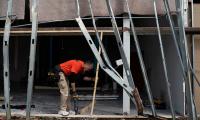Over the years, the Bagram Airbase, originally built by the Soviets in the 1950s and known to US personnel as Bagram Airfield, became a loud statement of occupation, able to hold up to 10,000 troops and sprawling across 30 square miles. It was also replete with cholesterol hardening fast food restaurants (Pizza Hut, Burger King), jewellers, car dealerships and such amenities as swimming pools, spas and cinemas.
Bagram also had room to accommodate the unfortunates captured in that anomalously worded ‘War on Terror’: detainees, many al-Qaeda suspects, faced torture in what came to be known as Afghanistan’s Guantanamo. US forces relinquished control of the prison, now sporting the benign name of Parwan Detention Facility, to Afghan security forces in December 2014. Ill-treatment of prisoners continued.
After two decades, it seemed that the US armed forces could not wait to leave. The departure date, scheduled for September, was being brought forward, though President Joe Biden denied that anything had changed. “A safe, orderly drawdown,” stated the Pentagon press secretary John Kirby, “enables us to maintain an ongoing diplomatic presence, support the Afghan people and the government, and prevent Afghanistan from once again becoming a safe haven for terrorists that threatens our homeland.”
There was little fuss in the way things unfolded on July 1 – at least initially. The New York Times observed that the final withdrawal “occurred with little fanfare and no public ceremony, and in an atmosphere of grave concern over the Afghan security forces’ ability to hold off Taliban advances across the country.”
The signal for chaos and mayhem had been given. Darwaish Raufi, Afghanistan’s district administrator for Bagram, found himself confronting an ominous spectacle. There had been confusion and uncertainty about the logistics of the operation. With the base unsecured, around 100 looters capitalised, seizing gas canisters and laptops. “They were stopped and some have been arrested and the rest have been cleared from the base.” The district governor was left puzzled. “American soldiers should share information with the Afghan government, especially local officials, but they didn’t let me know.”
US military spokesman Colonel Sonny Leggettdisagreed. “All handovers of Resolute Support bases and facilities, to include Bagram Airfield, have been closely coordinated, both with senior leaders from the government and with our Afghan partners in the security forces, including leadership of the locally based units respective to each base.”
Excerpted: ‘Leaving Bagram’
Counterpunch.org
Beijing was among first to denounce the tariffs, calling them “unjustifiable” and vowing strong countermeasures
With this unprecedented buildup, Diego Garcia has transformed into ticking time bomb of apocalyptic power
Pakistan is among world’s most climate-vulnerable nations, despite contributing minimally to global emissions
‘Azazeel’ is perhaps the most controversial novel to come out in Egypt this century
Dr Haroon Ahmed was an exceptional person, a precious human being who strived, throughout his long life
Pakistan can't afford another status quo budget so it must be budget of imagination, risk-taking and system-level...







